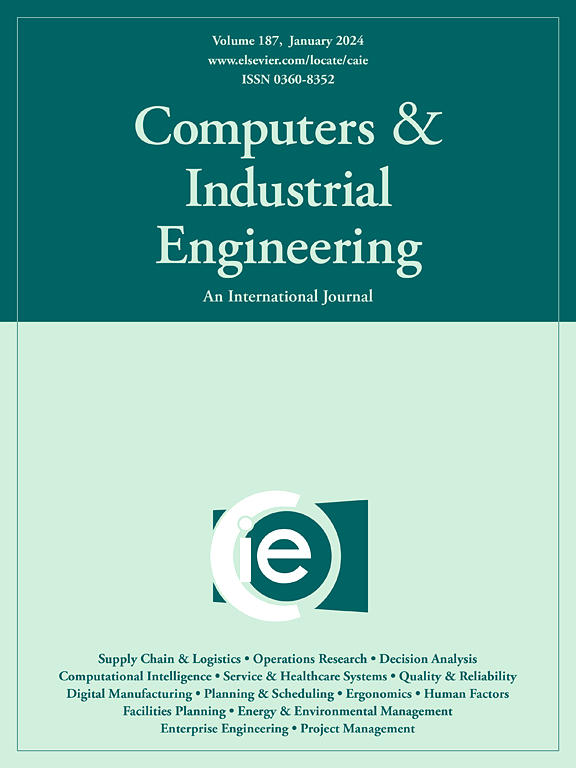基于多层熵的时间序列预测框架及其在制造业中的应用
IF 6.7
1区 工程技术
Q1 COMPUTER SCIENCE, INTERDISCIPLINARY APPLICATIONS
引用次数: 0
摘要
准确的预测对制造系统的生产计划、库存管理和资源分配至关重要。然而,管理不同复杂性的多个时间序列数据集带来了重大挑战,因为传统的统计模型通常无法捕获复杂的模式,而更先进的深度学习方法虽然强大,但在计算上可能会很昂贵。尽管如此,这些尖端的方法并不总是必要的,因为更直接的机器学习(ML)技术在许多情况下可以达到相当的性能。因此,平衡准确性和效率需要确定何时升级到复杂的模型。本研究介绍了运行时间序列预测和基于熵的评估系统(SOT-FER),该系统使用一套熵度量(香农、光谱、分散、排列和多尺度)以及趋势、季节性、剩余变异性和平稳性评估来量化时间序列复杂性。SOT-FER采用分层聚类方法按模式复杂程度对序列进行分组,并指导分层指定的预测方法的选择性应用。A层的特点是建立了统计和机器学习模型(状态空间指数平滑,自回归综合移动平均,Theta,先知,k近邻和随机森林),而B层则考虑长短期记忆(LSTM)网络专门用于最具挑战性的系列。应用于一家美国制造公司的128个月需求模式的真实数据集,SOT-FER准确地指出了先进方法带来显著收益的地方,表明与naïve基线相比,选择性部署a + B层可将预测精度提高50%以上。这个数据驱动的框架提供了一个可扩展的路线图,可以根据固有的复杂性对序列进行分类,从而改善不同背景下的预测策略。本文章由计算机程序翻译,如有差异,请以英文原文为准。
SOT-FER: A multi-tier entropy-based time series forecasting framework with an application to manufacturing
Accurate forecasting is crucial for manufacturing systems’ production planning, inventory management, and resource allocation. However, managing multiple time-series datasets of varying complexity poses significant challenges, as traditional statistical models often fail to capture intricate patterns, and more advanced deep learning approaches—though powerful—can be computationally expensive. Nonetheless, these cutting-edge approaches are not always necessary since more straightforward machine learning (ML) techniques can achieve comparable performance in many cases. Therefore, balancing accuracy with efficiency thus requires identifying when to escalate to sophisticated models. This study introduces the System for Operational Time-series Forecasting and Entropy-based Review (SOT-FER), which uses a suite of entropy measures (Shannon, spectral, dispersion, permutation, and multiscale) alongside assessments of trend, seasonality, residual variability, and stationarity to quantify time-series complexity. SOT-FER employs hierarchical clustering to group series by level of pattern intricacy and guides the selective application of forecasting methods designated in tiers. Tier A features established statistical and ML models (State Space Exponential Smoothing, AutoRegressive Integrated Moving Average, Theta, Prophet, K-Nearest Neighbors, and Random Forest), while Tier B considers Long Short-Term Memory (LSTM) networks exclusively for the most challenging series. Applied to a real-world dataset of 128 monthly demand patterns from a U.S.-based manufacturing corporation, SOT-FER accurately pinpoints where advanced methods deliver significant gains, showcasing that selective Tier A + Tier B deployment improved forecast accuracy by over 50 % compared to a naïve baseline. This data-driven framework offers a scalable roadmap for improving forecasting strategies across diverse contexts by categorizing series according to inherent complexity.
求助全文
通过发布文献求助,成功后即可免费获取论文全文。
去求助
来源期刊

Computers & Industrial Engineering
工程技术-工程:工业
CiteScore
12.70
自引率
12.70%
发文量
794
审稿时长
10.6 months
期刊介绍:
Computers & Industrial Engineering (CAIE) is dedicated to researchers, educators, and practitioners in industrial engineering and related fields. Pioneering the integration of computers in research, education, and practice, industrial engineering has evolved to make computers and electronic communication integral to its domain. CAIE publishes original contributions focusing on the development of novel computerized methodologies to address industrial engineering problems. It also highlights the applications of these methodologies to issues within the broader industrial engineering and associated communities. The journal actively encourages submissions that push the boundaries of fundamental theories and concepts in industrial engineering techniques.
 求助内容:
求助内容: 应助结果提醒方式:
应助结果提醒方式:


